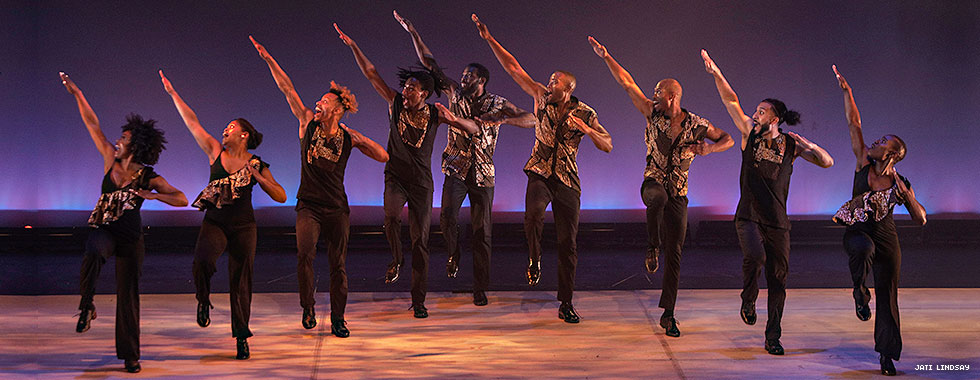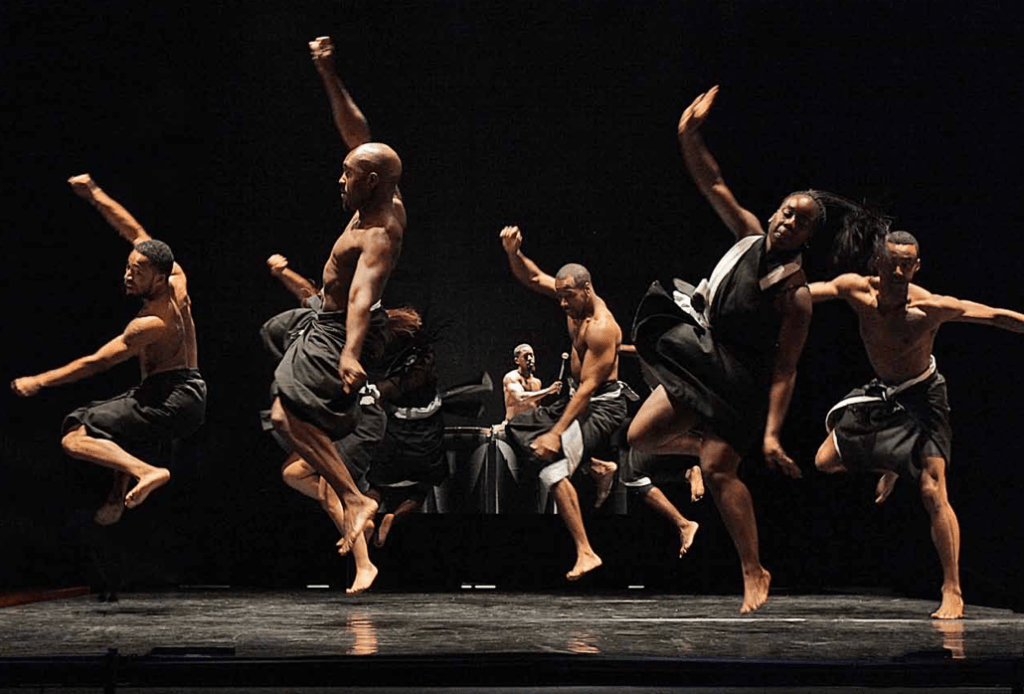
Not familiar with step? Don’t despair. Even people who’ve seen it performed may not have realized it had a name. A dance form that took root on college campuses in the early 1900’s, it’s profile in recent decades has risen well above the cloistered walls of higher learning. High spirited, intense, exciting and incorporating lots of very fast, very sharp moves, step was once the exclusive domain of fraternities and sororities in historically black colleges and universities. Prowess in the dance form often became points of competition between houses in the fraternity and sorority system. It’s now a revered tradition. And, as an entertainment form that feeds on energy, it’s also a massive crowd pleaser.
That appeal shone in high relief Saturday night at the Auditorium Theatre when Step Afrika! electrified the hall’s hallowed stage with exemplary dance skill before a very receptive audience. This crowd not only knew what to expect, you could sense they had very high standards and were there to witness excellence. Step Afrika! more than complied. A hybrid dance form that carries the DNA of two continents, step is a remarkable product of creative ingenuity. Full of power, purpose and positivity, it was telling that so many people had brought their children, from toddlers to teens, to the dance concert. There’s something about the exuberance of step performances that stimulate notions of possibility. It was clear after the company completed Tribute, its opening homage to the American step show, that the ensemble was aiming for something well beyond enjoyable entertainment. Their achieved aim was to be spellbinding and in the process, offer a few helpings of inspiration.
Step styles vary noticeably between sororities and fraternities. Tribute combined them and employed other elements often used in a step dance performance, like props and highly distinctive floor work, to give a full expression of what step is. Although the show would make American step its foundation, other distinctly African influences were also on display. That convergence is what Step Afrika! personifies.

Unlike any other dance performance style, audience participation is a key element of step. Beyond being tremendously energetic and polyrhythmic, step is defined by sheer energy and momentum. Its beauty relies on innovative movement, total synchronization and power. That last attribute you might be inclined to associate solely with male dancers. But the women of Step Afrika! proved that they were just as capable of explosive displays of dance dominance. Like the men, the troupe’s female dancers displayed superb dance virtuosity in every piece the ensemble presented. One dancer, Valencia Springer, possessed that extra bit of charisma and talent that drew notice throughout the evening. She was sensational in Ndlamu, a traditional dance of the Zulu people of South Africa. The piece was one the highlights of the show and allowed the company to display their mastery of a complementary, but very different, dance form. Also, by including ample solo pieces for each dancer, Ndlamu showcased the unique gifts of the ensemble’s individual dancers. Choreographed by Jackie Semela, the dance turned technical complexity into magnificent spectacles of movement. Step Afrika! has enjoyed a long relationship with the Soweto Dance Theater. That partnership has allowed them to absorb a deep understanding of the psychic impact of dance. Ndlamu shows how well and how powerfully they communicate that understanding. Musically drenched in mesmerizing drums, Ndlamu kept building on undulating crescendoes. Springer proved the ideal dancer to close it with characteristic daring and bravado.
With no intermission, the program swept through a series of dance skits that were introduced and explained by various members of the company. They all provided a look at step from different perspectives. Isicathulo, or the gumboot dance, also has South African origins and bears striking similarities to step. Born out of necessity and protest, it’s an example of how people used their artistic imagination to overcome repression. In the gumboot dance, we see how the percussive sound of boots could circumvent restrictions on speech in the time of apartheid. Other dance segments pitted male dancers against female dancers, letting the audience decide who prevailed through applause and cheers. Because of its tendency to surge and command, step has always been viewed as dance of the collective or group. Solo narrowed the focus and showed what step looks like with just one dancer. Although it was easier to see its kinship to tap during the solo routines, step’s expansiveness and interpretative focus revealed why it belongs in its own dance universe.
Invested and enthralled after Step Afrika!’s one night occupation of the Auditorium, the audience was left both buoyed and a little drained. Exhilaration can carry a cost. From the sound of the ovations, it was a cost well spent.
Step Afrika!
January 14, 2023
Auditorium Theatre
50 East Ida B. Wells Dr.
Chicago, IL 60605
www.stepafrika.org